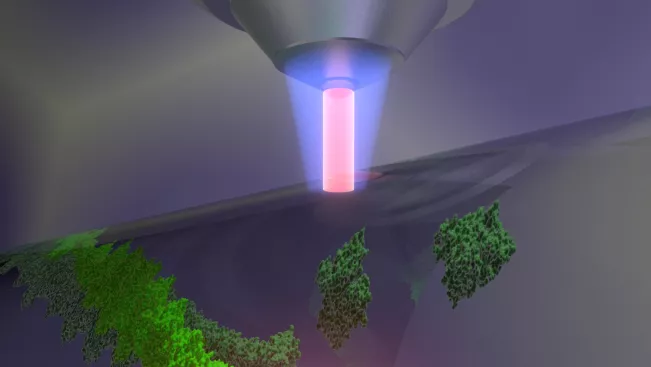Institut für funktionale Gen-Analytik (IFGA)

Gliederung
Fachbereich Angewandte Naturwissenschaften, Institut für funktionale Gen-Analytik (IFGA), Institut für Technik, Ressourcenschonung und Energieeffizienz (TREE)
Standort
Rheinbach
Raum
E004
Adresse
von-Liebig-Straße 20
53359, Rheinbach
Telefon
+49 2241 865 9851Profil
Forschungsgebiet
- Analyse und rationale, computergestützte Entwicklung niedermolekularer Modulatoren im Kontext genetischer und Infektionserkrankungen
- Entschlüsselung der molekularen Mechanismen und allosterischer Kopplung in Molekularen Motoren
- Untersuchung krankheitsrelevanter Mutationen auf atomarer Ebene und ihre Auswirkungen auf die Proteinstruktur und Konformationsdynamik
Methoden
- Röntgenkristallographische Analyse von Proteinen und Protein-Ligand-Komplexen
- High-Performance Computing und Simulationen
- Computergestütztes Wirkstoffdesign
- Biophysikalische Bindungs- und Aktivitätsassays
- Chemische Synthese und Analytik niedermolekularer Modulatoren
Lehrveranstaltungen
- Structural Biology
- Advanced Analytical Methods 1 (Infrared Spectroscopy)
- Physikalische Chemie 2 - Struktur der Materie und Quantenchemie
- Computational Biology and Programming
- Structural Bioinformatics
Mitgliedschaften
Forschungsprojekte
Eine aus vier Komponenten bestehende Analyseplattform bietet eine erhebliche Ausweitung der biomedizinischen Analysemöglichkeiten an der Hochschule Bonn-Rhein-Sieg (H-BRS). Ein Bindungsanalyse-Gerät auf Basis der Mikroskaliertene Thermophorese trägt einen innovativen Ansatz bei zur Charakterisierung von Wechselwirkungen unter Protein-Beteiligung, ein Multi-Modus Detektionsgerät für UV/Vis, Fluoreszenz und Lumineszenz erlaubt u.a. eine Vielzahl von Enzymaktivitätstests und bildgebende Untersuchungen in neuer oder verbesserter Form, ein automatisiertes Patch-Clamp System und ein System für Solid-supported membrane (SSM)-basierte Elektrophysiologie für hochaufgelöste Transporter-Untersuchungen liefern apparative Grundlagen für einen Ausbau der Forschung zu Membrantransportprozessen und anderen molekularen Mechanismen der Krankheitsentstehung.
Projektleitung an der H-BRS
Prof. Dr. Jörn Oliver SassDie bio-chemische Forschung ist zunehmend auf akkurate Computermodellierung und -analyse angewiesen. Dieses Forschungsfeld ist naturgemäß hoch interdisziplinär, da physikalische Grundgesetze algorithmisch umgesetzt werden müssen, um in Anwendungen der Lebenswissenschaften relevante Beiträge liefern zu können. Das Projekt und die damit verbundene Initiative UMMBAS bündelt disziplinübergreifend die starke Expertise an der H-BRS in der Methodenentwicklung, der Visualisierung und der Anwendung computergestützter Verfahren zur Entschlüsselung materialwissenschaftlicher und biochemischer Fragestellungen.
Projektleitung an der H-BRS
Prof. Dr. Matthias PrellerDie biomolekulare Röntgenkristallographie erlaubt hochauflösende Einsichten in die Architektur von Zellen und zelluläre Prozesse. Der limitierende Faktor der Röntgenkristallographie besteht in der zwingend notwendigen Überführung der Biomoleküle in den kristallinen Zustand (die Erzeugung sogenannter Einkristalle). Dieses Projekt soll über den Einsatz eines automatisierten Robotersystems den Kristallisationsprozess und die Optimierung von Kristallisationsbedingungen effizienter und ressourcenschonender gestalten. In Verbindung mit einem am Standort vorhandenen µ-Fokus-Röntgendiffraktometer und umfangreicher biophysikalischer Analysetechniken steht damit eine Pipeline für Struktur-Funktions-Studien zur Verfügung, die zur grundlagenorientierten Erforschung molekularer Krankheitsmechanismen und der anwendungsorientierten strukturbasierten Wirkstoffentwicklung eingesetzt wird.
Projektleitung an der H-BRS
Prof. Dr. Matthias PrellerPublikationen
Originalartikel (peer-reviewed)
Lin, J., Gettings, S.M., Talbi, K., Schreiber, R., Taggart, M.J., Preller, M., Kunzelmann, K., Althaus, M., Gray, M.A. (2022) Pharmacological inhibitors of the cystic fibrosis transmembrane conductance regulator exert off-target effects on epithelial cation channels. Pflugers Arch. doi: 10.1007/s00424-022-02758-9. Epub ahead of print.
Fan, L., Warnecke, A., Weder, J., Preller, M., Zeilinger, C. (2022) Triiodothyronine acts as a smart influencer of Hsp90 via a triiodothyronine binding site. Int. J. Mol. Sci., 23, 7150.
Förster, A., Brand, F., Banan, R., Hüneburg, R., Weber, C.A.M., Ewert, W., Kronenberg, J., Previti, C., Elyan, N., Beyer, U., Martens, H., Hong, B., Bräsen, J.H., Erbersdobler, A., Krauss, J.K., Stangel, M., Samii, A., Wolf, S., Preller, M., Aretz, S., Wiese, B., Hartmann, C., Weber, R.G. (2021) Rare germline variants in the E-cadherin gene CDH1 are associated with the risk of brain tumors of neuroepithelial and epithelial origin. Acta Neuropathol., 142, 191-210.
Franz, P., Ewert, W., Preller, M., Tsiavaliaris, G. (2021) Unraveling a Force-Generating Allosteric Pathway of Actomyosin Communication Associated with ADP and Pi Release. Int. J. Mol. Sci., 22, 104.
Ewert, W., Franz, P., Tsiavaliaris, G., Preller, M. (2020) Structural and computational insights into a blebbistatin-bound myosin•ADP complex with characteristics of an ADP-release conformation along the two-step myosin power stroke. Int. J. Mol. Sci., 21, 7417.
Viswanathan, M.C., Schmidt, W., Franz, P., Rynkewiecz, M.J., Newhard, C.S., Madan, A., Lehman, W., Swank, D.M., Preller, M.* and Cammarato, A.* (2020) A role for actin flexibility in thin filament-mediated contractile regulation and myopathy. Nat. Commun., 11, 2417-2432.
Osmanovic, A., Widjaja, M., Förster, A., Weder, J., Wattjes, M.P., Lange, I., Sarikidi, A., Auber, B., Raab, P., Christians, A., Preller, M., Petri, S., Weber, R.G. (2020) SPG7 mutations in amyothrophic lateral sclerosis: a genetic link to hereditary spastic paraplegia. J. Neurol., 267, 2732-2743.
Chaturvedi, A., Goparaju, R., Gupta, C., Klünemann, T., Cruz, M.M.A., Kloos, A., Goerlich, K., Schottmann, R., Struys, E.A., Ganser, A., Preller, M.* and Heuser, M.* (2019) In vivo efficacy of mutant IDH1 inhibitor HMS-101 and structural resolution of distinct binding site. Leukemia, 34, 416-426.
Shcherbakova, A., Preller, M., Taft, M.H., Pujols, J., Ventura, S., Tiemann, B., Buettner, F.F.R., Bakker, H. (2019) C-mannosylation supports folding and enhances stability of thrombospondin repeats. Elife. 8, e52978.
Ehlert, J., Kronemann, J., Zumbrägel, N., Preller, M. (2019) Lipase-catalyzed chemoselective ester hydrolysis of biomimetically coupled aryls for the synthesis of unsymmetric biphenyl esters. Molecules, 24, 4272.
Schadzek, P., Stahl, Y., Preller, M., Ngezahayo, A. (2019) Analysis of the dominant mutation N188T of human connexin46 (hCx46) using concatenation and molecular dynamics simulation. FEBS Open Bio., 9, 840-850.
Roberts, S., Seeger, M., Jiang, Y., Mishra, A., Sigmund, F, Stelzl, A., Lauri, A., Symvoulidis, P., Rolbieski, H., Preller, M., Deán-Ben, X.L., Razansky, D., Orschmann, T., Desbordes, S.C., Vetschera, P., Bach, T., Ntziachristos, V., Westmeyer, G.G. (2018). Calcium sensor for photoacoustic imaging. J. Am. Chem. Soc., 140, 2718-2721.
Chinthalapudi, K., Heissler, S., Preller, M., Sellers, J., Manstein, D.J. (2017). Mechanistic insights into the active site and allosteric communication pathways in human nonmuscle myosin-2C. Elife, 6, e32742.
Beyer, U., Brand, F., Martens, H., Weder, J., Christians, A., Elyan, N., Hentschel, B., Westphal, M., Schackert, G., Pietsch, T., Hong, B., Krauss, J.K., Samii, A., Raab, P, Das, A., Dumitru, C.A., Sandalcioglu, I.E., Hakenberg, O.W., Erbersdobler, A., Lehmann, U., Reifenberger, G., Weller, M., Reijns, M.A.M., Preller, M., Wiese, B., Hartmann, C., Weber, R.G. (2017). Rare ADAR and RNASEH2B variants and a type I interferon signature in glioma and prostate carcinoma risk and tumorigenesis. Acta Neuropathol., 134, 905-922.
Mohammadi-Ostad-Kalayeh, S., Hrupins, V., Helmsen, S., Ahlbrecht, C., Stahl, F., Scheper, T., Preller, M., Surup, F., Stadler, M., Kirschning, A., and Zeilinger, C. (2017). Development of a microarray-based assay for efficient testing of new HSP70/DnaK inhibitors. Bioorg. Med. Chem., 25, 6345-6352.
Osmanovic, A., Rangnau, I., Kosfeld, A., Abdulla, S., Janssen, C., Auber, B., Raab, P., Preller, M., Petri, S., and Weber, R.G. (2017). FIG4 variants in central European patients with amyotrophic lateral sclerosis: a whole-exome and targeted sequencing study. Eur. J. Hum. Genet., 25, 324-331.
Schadzek, P., Schlingmann, B., Schaarschmidt, F., Lindner, J., Koval, M., Heisterkamp, A., Ngezahayo, A.* and Preller, M.* (2016). Data of the molecular dynamics simulations of mutations in the human connexin46 docking interface. Data Brief, 7, 93-99.
Schadzek, P., Schlingmann, B., Schaarschmidt, F., Lindner, J., Koval, M., Heisterkamp, A., Preller, M.* and Ngezahayo, A.* (2016). The cataract related mutation N188T in human connexin46 (hCx46) revealed a critical role for residue N188 in the docking process of gap junction channels. Biochim. Biophys. Acta, 1858, 57-66.
Schuster-Gossler, K., Cordes, R., Muller, J., Geffers, I., Delany-Heiken, P., Taft, M., Preller, M. and Gossler, A. (2016). Context-Dependent Sensitivity to Mutations Disrupting the Structural Integrity of Individual EGF Repeats in the Mouse Notch Ligand DLL1. Genetics, 202, 1119-1133.
Diensthuber, R.P., Tominaga, M., Preller, M., Hartmann, F.K., Orii, H., Chizhov, I., Oiwa, K., and Tsiavaliaris, G. (2015). Kinetic mechanism of Nicotiana tabacum myosin-11 defines a new type of a processive motor. FASEB J., 29, 81-94.
Hundt, N., Preller, M., Swolski, O., Ang, A.M., Mannherz, H.G., Manstein, D.J., and Muller, M. (2014). Molecular mechanisms of disease-related human beta-actin mutations p.R183W and p.E364K. FEBS J., 281, 5279-5291.
Martin, R., Risacher, C., Barthel, A., Jäger, A., Schmidt, A.W., Richter, S., Böhl, M., Preller, M., Chinthalapudi, K., Manstein, D.J., Gutzeit, H.O., and Knölker, H.-. (2014). Silver(I)-catalyzed route to pyrroles: Synthesis of halogenated pseudilins as allosteric inhibitors for myosin ATPase and x-ray crystal structures of the protein-inhibitor complexes. Eur. J. Org. Chem., 2014, 4487-4505.
Radke, M.B., Taft, M.H., Stapel, B., Hilfiker-Kleiner, D., Preller, M., and Manstein, D.J. (2014). Small molecule-mediated refolding and activation of myosin motor function. Elife, 3, e01603.
Chaturvedi, A., Araujo Cruz, M.M., Jyotsana, N., Sharma, A., Yun, H., Gorlich, K., Wichmann, M., Schwarzer, A., Preller, M., Thol, F., Meyer, J., Haemmerle, R., Struys, E.A., Jansen, E.E., Modlich, U., Li, Z., Sly, L.M., Geffers, R., Lindner, R., Manstein, D.J., Lehmann, U., Krauter, J., Ganser, A., Heuser, M. (2013). Mutant IDH1 promotes leukemogenesis in vivo and can be specifically targeted in human AML. Blood, 122, 2877-2887.
Müller, M., Diensthuber, R.P., Chizhov, I., Claus, P., Heissler, S.M., Preller, M., Taft, M.H., and Manstein, D.J. (2013). Distinct functional interactions between actin isoforms and nonsarcomeric myosins. PLoS One, 8, e70636.
Preller, M. and Manstein, D.J. (2013). Myosin structure, allostery, and mechano-chemistry. Structure, 21, 1911-1922.
Preller, M.* and Holmes, K.C.* (2013). The myosin start-of-power stroke state and how actin binding drives the power stroke. Cytoskeleton (Hoboken), 70, 651-660.
Chinthalapudi, K., Taft, M.H., Martin, R., Heissler, S.M., Preller, M., Hartmann, F.K., Brandstaetter, H., Kendrick-Jones, J., Tsiavaliaris, G., Gutzeit, H.O., Fedorov, R., Buss, F., Knölker, H.-J., Coluccio, L. M., Manstein, D. J. (2011). Mechanism and specificity of pentachloropseudilin-mediated inhibition of myosin motor activity. J. Biol. Chem., 286, 29700-29708.
Preller, M., Bauer, S., Adamek, N., Fujita-Becker, S., Fedorov, R., Geeves, M.A., and Manstein, D.J. (2011). Structural basis for the allosteric interference of myosin function by reactive thiol region mutations G680A and G680V. J. Biol. Chem., 286, 35051-35060.
Preller, M., Chinthalapudi, K., Martin, R., Knolker, H.J., and Manstein, D.J. (2011). Inhibition of Myosin ATPase activity by halogenated pseudilins: a structure-activity study. J. Med. Chem., 54, 3675-3685.
Preller, M., Grunenberg, J., Bulychev, V.P., and Bulanin, M.O. (2011). Calculation of the structure, potential energy surface, vibrational dynamics, and electric dipole properties for the Xe:HI van der Waals complex. J. Chem. Phys., 134, 174302.
Buchkapitel
Manstein, D.J. and Preller, M. (2020). Small molecule effectors of myosin function. In Advances in Experimental Medicine and Biology - Myosins, Springer Nature Ltd, ISBN: 978-3-030-38061-8.
Preller, M. and Manstein, D.J. (2017). Myosin motors: Structural aspects and functionality. In Reference Module in Life Sciences, Elsevier, ISBN: 978-0-12-809633-8.
Preller, M. and Manstein, D.J. (2012). Myosin motors: Structural aspects and functionality. In Comprehensive Biophysics, Academic Press, pp. 118-150, ISBN: 978-0-12-374920-8.
Patente
EP2727911 B1, Matthias Preller, Dietmar J. Manstein, Markus Kalesse, Novel means and methods for treating malaria and other parasitic disorders, 21.12.2016
US9499471 B2, Matthias Preller, Nina Díaz Gomez, Dietmar J. Manstein, Marcus Furch, Markus Kalesse, Biphenyl compounds for use in treating malaria and other parasitic disorders, 22.11.2016
EP2996692 A2, Michael Heuser, Anuhar Chaturvedi, Matthias Preller, Means and methods for treating cancer, 23.03.2016

